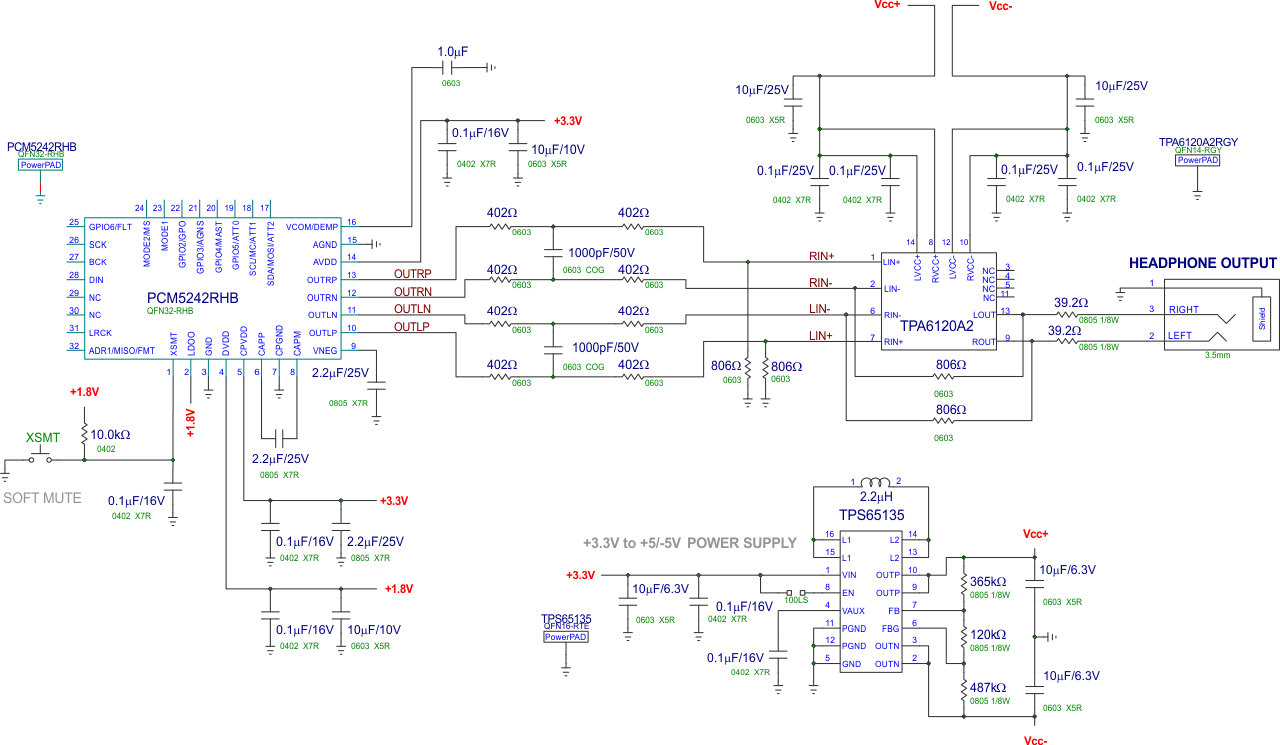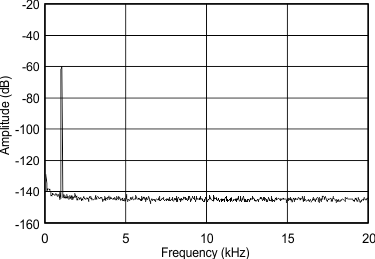ZHCSDH3 November 2014 PCM5252
PRODUCTION DATA.
- 1 特性
- 2 应用
- 3 说明
- 4 修订历史记录
- 5 Device Comparison
- 6 Pin Configuration and Functions
-
7 Specifications
- 7.1 Absolute Maximum Ratings
- 7.2 ESD Ratings
- 7.3 Recommended Operating Conditions
- 7.4 Thermal Information
- 7.5 Electrical Characteristics
- 7.6 Switching Characteristics
- 7.7 Timing Requirements: SCK Input
- 7.8 Timing Requirements: PCM Audio Data
- 7.9 Timing Requirements: I2S Master, See
- 7.10 Timing Requirements: XSMT
- 7.11 Typical Characteristics
-
8 Detailed Description
- 8.1 Overview
- 8.2 Functional Block Diagram
- 8.3
Feature Description
- 8.3.1 Terminology
- 8.3.2 Audio Data Interface
- 8.3.3 XSMT Pin (Soft Mute / Soft Un-Mute)
- 8.3.4 Audio Processing
- 8.3.5 DAC and Differential Analog Outputs
- 8.3.6
Reset and System Clock Functions
- 8.3.6.1 Clocking Overview
- 8.3.6.2 Clock Slave Mode With Master and System Clock (SCK) Input (4 Wire I2S)
- 8.3.6.3 Clock Slave Mode With BCK PLL to Generate Internal Clocks (3-Wire PCM)
- 8.3.6.4 Clock Generation Using the PLL
- 8.3.6.5 PLL Calculation
- 8.3.6.6 Clock Master Mode from Audio Rate Master Clock
- 8.3.6.7 Clock Master from a Non-Audio Rate Master Clock
- 8.4 Device Functional Modes
- 9 Application and Implementation
- 10Power Supply Recommendations
- 11Layout
- 12Programming
- 13Register Maps
- 14器件和文档支持
- 15机械、封装和可订购信息
9 Application and Implementation
NOTE
Information in the following applications sections is not part of the TI component specification, and TI does not warrant its accuracy or completeness. TI’s customers are responsible for determining suitability of components for their purposes. Customers should validate and test their design implementation to confirm system functionality.
9.1 Application Information
9.2 Typical Application
Differential outputs DAC's are regularly used where higher performance is required from them compared to single ended output DACs. They offer twice as much output voltage for the same power supply, along with noise cancelling effect of differential signaling. The PCM5252 makes an ideal front end for both analog input speaker amplifiers and headphone amplifiers with its higher voltage differential output and low noise floor.
9.2.1 High Fidelity Smartphone Application
A new trend in portable applications are termed "Hifi Smartphones". In these systems, a standard portable audio codec continues to be used for telephony, while a separate, higher performance DAC and Headphone Amplifier is used for music playback.
Figure 73 shows a complete circuit schematic for such a system. The digital audio is fed into a high performance DAC. The PCM5252 is a 32-bit, stereo DAC. The PCM5252 is pin to pin and register set compatible with the PCM5242. The PCM5252 contains an expanded ROM that contains the Smart Amplifier Algorithm components.
 Figure 73. High Fidelity Smartphone Application
Figure 73. High Fidelity Smartphone Application
9.2.1.1 Design Requirements
- Directpath output to headphone amplifier
- 1VRMS output, as 2VRMS may cause hearing damage into low impedance headphones
- Stereo differential inputs (DAC is differential)
- Be transparent to the user. (DAC SNR and THD+N performance all the way to the headphone)
- Automatic fS switching up to 384kHz
- 3-wire I2S source
9.2.1.2 Detailed Design Procedure
For optimal performance, the TPA6120A2 is configured for use with differential inputs, stereo use, and a gain of 1V/V.
The TPA6120A2 requires a bipolar power supply to drive a ground centered output. The application employs a TPS65135 DC-DC converter that generates ±5V from a single 3.3V supply.
The PCM5252 DAC is configured for a 1VRMS output so that clipping is avoided should the 3.3V power supply sag. The PCM5252 offers a ground centered output, so that no DC blocking capacitors are required between it and the TPA6120A2. (Page 1, Register 2)
9.2.1.2.1 Initialization Script
w 98 00 01 # PCM5252 to Page 1
w 98 02 11 # PCM5252 output to 1 Vrms
w 98 00 00 # PCM5252 back to page 0
w 98 3B 66 # set auto mute time to six seconds of audio zero.
w 98 3C 01 # Left Vol register controls both
w 98 3D 4F # Change left channel volume, right will follow.
w 98 3F BB # set vol changes for every 4 samples, 0.5 sample steps.
9.2.1.3 Application Performance Plot

In this particular application, the TPA6120A2's performance is transparent and the performance of the system is dictated by the PCM5252 DAC, even into a 32-Ω headphone load.